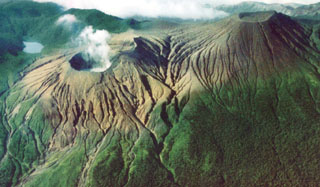Report on Rincon de la Vieja (Costa Rica) — March 2000
Bulletin of the Global Volcanism Network, vol. 25, no. 3 (March 2000)
Managing Editor: Richard Wunderman.
Rincon de la Vieja (Costa Rica) Non-eruptive through November 1999 but with ongoing tremor
Please cite this report as:
Global Volcanism Program, 2000. Report on Rincon de la Vieja (Costa Rica) (Wunderman, R., ed.). Bulletin of the Global Volcanism Network, 25:3. Smithsonian Institution. https://doi.org/10.5479/si.GVP.BGVN200003-345020
Rincon de la Vieja
Costa Rica
10.83°N, 85.324°W; summit elev. 1916 m
All times are local (unless otherwise noted)
The noisy escape of fumarolic gases continued at Rincón de la Vieja during June-November 1999. A summary of monitoring data appears in table 3. During August the crater floor became covered with a shallow ephemeral lake, covering the fumaroles there. Plumes then rose less than 100 m above their fumarolic sources. The active crater lake, with a sky-blue color, had a temperature of 36°C; the maximum measured fumarole temperature was 70°C.
Table 3. Geotechnical data at Rincón de la Vieja, July-November 1999. Seismic data recorded at station RIN3, 5 km SW of the active crater, includes microseisms who's amplitudes were under 5 mm, and those volcano-tectonic (VT) earthquakes with S minus P arrival times under 1.5 seconds (i.e. focused near the volcano). The reported tremor durations were sums of discontinuous segments, and were low-frequency (below 2 Hz). Courtesy of OVSICORI-UNA.
| Month | Low-frequency earthquake | Microseism (amplitude <5 mm) | VT earthquake | Tremor duration |
| Jul 1999 | 9 | 2 | 2 hours | -- |
| Aug 1999 | 8 | 1 | 14 | 0.5 hours |
| Sep 1999 | 5 | 21 | 4 | 0.75 hours |
| Oct 1999 | 4 | 12 | 4 | 6.5 hours |
| Nov 1999 | 6 | 5 | 0 | 2 hours |
Geological Summary. Rincón de la Vieja, the largest volcano in NW Costa Rica, is a remote volcanic complex in the Guanacaste Range. The volcano consists of an elongated, arcuate NW-SE-trending ridge constructed within the 15-km-wide early Pleistocene Guachipelín caldera, whose rim is exposed on the south side. Sometimes known as the "Colossus of Guanacaste," it has an estimated volume of 130 km3 and contains at least nine major eruptive centers. Activity has migrated to the SE, where the youngest-looking craters are located. The twin cone of Santa María volcano, the highest peak of the complex, is located at the eastern end of a smaller, 5-km-wide caldera and has a 500-m-wide crater. A Plinian eruption producing the 0.25 km3 Río Blanca tephra about 3,500 years ago was the last major magmatic eruption. All subsequent eruptions, including numerous historical eruptions possibly dating back to the 16th century, have been from the prominent active crater containing a 500-m-wide acid lake located ENE of Von Seebach crater.
Information Contacts: E. Fernandez, E. Duarte, V. Barboza, R. Sáenz, E. Malavassi, R. Van der Laat, T. Marino, J. Barquero, and E. Hernández, Observatorio Vulcanológico y Sismológico de Costa Rica, Universidad Nacional (OVSICORI-UNA), Apartado 86-3000, Heredia, Costa Rica.

